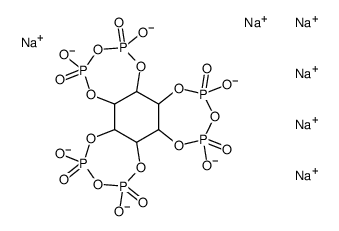myo-Inositol Trispyrophosphate Hexasodium Salt
Modify Date: 2025-08-26 23:54:39

myo-Inositol Trispyrophosphate Hexasodium Salt structure
|
Common Name | myo-Inositol Trispyrophosphate Hexasodium Salt | ||
|---|---|---|---|---|
| CAS Number | 23103-35-7 | Molecular Weight | 737.88000 | |
| Density | N/A | Boiling Point | N/A | |
| Molecular Formula | C6H6Na6O21P6 | Melting Point | N/A | |
| MSDS | N/A | Flash Point | N/A | |
Use of myo-Inositol Trispyrophosphate Hexasodium Saltmyo-Inositol trispyrophosphate (ITPP) hexasodium, a modifier of haemoglobin, is an allosteric effector that reduces the oxygen‐binding affinity of haemoglobin and facilitates the release of oxygen by red blood cells. myo-Inositol trispyrophosphate can reverse hypoxia, control tumor growth and improve chemotherapy response[1][2][3]. |
| Name | ITTP Hexasodium Salt |
|---|---|
| Synonym | More Synonyms |
| Description | myo-Inositol trispyrophosphate (ITPP) hexasodium, a modifier of haemoglobin, is an allosteric effector that reduces the oxygen‐binding affinity of haemoglobin and facilitates the release of oxygen by red blood cells. myo-Inositol trispyrophosphate can reverse hypoxia, control tumor growth and improve chemotherapy response[1][2][3]. |
|---|---|
| Related Catalog | |
| In Vitro | myo-Inositol trispyrophosphate hexasodium (10 mmol/L; 2 hours) significantly inhibits OCR in all six cell lines (FSaII, SiHa, MDA‐MB‐231, NT2, 9L‐glioma and rhabdomyosarcoma) [2]. |
| In Vivo | myo-Inositol trispyrophosphate hexasodium (2 g/kg weekly; IP; 7weeks) sustains its significant effect on life prolongation[1]. myo-Inositol trispyrophosphate hexasodium (1.5 g/kg weekly; IV; for 8 weeks) remains metastasis-free on pancreatic carcinomas in immunocompetent male Lewis rats weighing 120-150 g with DSL-6A/C1 cells. myo-Inositol trispyrophosphate hexasodium restores the pO2 pressure in tumors reducing hypoxia-inducible and proangiogenic factors[1]. myo-Inositol trispyrophosphate hexasodium (2 g/kg; once daily for 2 days) shows the most elevated tumour oxygenation at 2 hours in four mouse tumour models (mouse fibrosarcoma FSaII implanted in C3H mice, mouse mammary tumour NT2 in FVb/Nrj mice, human breast cancer MDA‐MB‐231 in NMRI nude mice and human cervix squamous cell carcinoma SiHa in NMRI nude mice) and two rat tumour models (rat 9L‐glioma in Fischer F344 rats and rat rhabdomyosarcoma in WAG/Rij rats)[1]. Animal Model: Nude mice (20 g) with MiaPaCa-2 or DSL-6A/C1 cells[1] Dosage: 2 g/kg (weekly) Administration: IP; weekly; 7weeks Result: Sustained its significant effect on life prolongation. |
| References |
| Molecular Formula | C6H6Na6O21P6 |
|---|---|
| Molecular Weight | 737.88000 |
| Exact Mass | 737.72100 |
| PSA | 382.71000 |
| LogP | 2.63340 |
| InChIKey | DTOYSAZRROROSE-UHFFFAOYSA-H |
| SMILES | O=P1([O-])OC2C3OP(=O)([O-])OP(=O)([O-])OC3C3OP(=O)([O-])OP(=O)([O-])OC3C2OP(=O)([O-])O1.[Na+].[Na+].[Na+].[Na+].[Na+].[Na+] |
| myo-Inositol Trispyrophosphate Hexasodium Salt |
| ITPP SODIUM SALT |